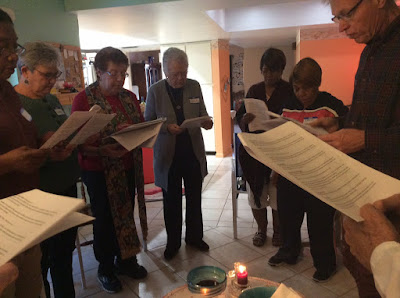The Guadalupe Story
The Blessed Virgin Mary
appeared to St. Juan Diego in
the 16th century in present day Mexico City, Mexico. Juan Diego saw an
apparition of the Blessed Virgin on the Hill of Tepeyac on December 9, 1531,
which happened to be the feast day of the Immaculate Conception in that time.
Our Lady requested that a church be built on that site, which Juan Diego
dutifully relayed to the bishop.
After a request by the
bishop to prove her identity, Our Lady asked Juan Diego to gather roses that
were growing on the hill (which were neither native to the area nor in season)
and take them to the bishop. Juan Diego obeyed and placed the roses in his
tilma (or cloak) to carry back to the bishop as evidence of Our Lady’s
appearance.
Upon opening the tilma
to reveal the miraculous roses to the bishop, there was something even more
miraculous present in the tilma–a striking image of the Blessed Virgin Mary.
In the image Our Lady
wears the traditional garments of an Aztec princess. A black sash around
her waist was a cultural tradition among the Aztec women that indicated
pregnancy. All the elements of the image point to Our Lady as being above
the gods the Aztecs worshiped, while at the same time showing that she herself
was submissive to the true Creator God while being pregnant with the Divine
God-man that grew in her womb.
By using only cultural
symbols and no words, which the Aztec people could read as a codex, the miraculous
image on the tilma spoke the truth of the Christian faith that the Spanish
Catholic missionaries proclaimed.
A mass conversion of
millions upon millions of Aztecs to the Catholic faith soon followed–ending the
human sacrifices, especially child sacrifices, that they practiced. Many Church
historians also connect this mass conversion of souls to the Catholic faith as
heaven’s balance to the massive number of souls who left the Church during the
Protestant revolt, a tragedy which was happening during the same period in
Catholic Europe.
A church was built at
Our Lady’s request on the Hill of Tepeyac to mark the apparition site, and
today it is the most visited Catholic pilgrimage shrine in the world. Venerated
in this cathedral is the original tilma of St. Juan Diego, which still displays
the miraculous Our Lady of Guadalupe image. The image has been subjected to
scientific testing to prove its authenticity and miraculous properties.
THE
MIRACULOUS IMAGE
Here are just a few from
a long list of interesting facts about the Our Lady of Guadalupe image itself:
·
The image is proven to not be painted by human
hands
·
The image and fabric have miraculously lasted in
its original condition for nearly 500 years
·
The weak cactus fiber, of which the tilma was
made, should have decomposed within 15-20 years of being woven
·
No natural or animal mineral colorings, or
paint, are found on the image
·
The image itself is iridescent, which cannot be
produced by hand
·
Mary stands on a crescent moon, the same
crescent moon in the sky on the day of her apparition
·
Mary’s mantel is a constellation map, the same
constellations in the sky as on the day of her apparition
·
These constellations tell the story of the
Gospel with the arrangements of Leo in the womb of Virgo
·
On her rose garment is a topographic map of the
geographic location of her apparition
·
On Mary’s neck is a small black cross,
identifying her with the Catholic missionary priests
·
Over her womb on her dress is a four-petal
flower, the Aztec symbol of life and deity
·
In the image Mary is “clothed with the sun” with
“the moon at her feet” as described in Revelation 12:1
·
A doctor once heard a heartbeat coming from the
image through a stethoscope over the womb
·
·
The eyes of the image have the refractory
characteristics of human eyes
·
·
The eyes, when examined through a microscope,
reflect the images of the witnesses present at its unveiling, including Juan
Diego and the bishop
-->










No comments:
Post a Comment